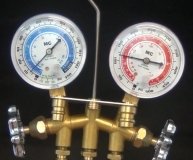I have a problem and I’m not sure how to proceed. I’m hoping you can give me some advice.
As I said before, I’m replacing my head gaskets, cam roller followers, timing hardware and oil pump, but this is all stuff I’m doing because I’ll be so deep into the engine anyway. The other reason I’m that deep into the engine is that a small magnet was accidentally dropped down the spark plug hole of the #2 cylinder. I have tried to fish it out, but there’s just no way. I decided to pull the head so I could get the magnet out of that cylinder. I have not attempted to start the motor or move the crankshaft ever since the magnet was lost in the cylinder.
Here’s my problem. The tech manual and several other references (Youtube, etc.) Indicate that I’m supposed to turn the crankshaft until the keyway is at 12 O’clock and the RH cam lobes for cylinder 1 and 4 are in such a position that the cam followers can be removed for the exhaust valve on cylinder 1 and the intake valves on cylinder 4. This should also put the LH cam lobes for cylinder 5 an 8 in such a position that the cam followers can be removed for the cylinder 5 intake valves and cylinder 8 exhaust valve. This apparently removes tension on the cam so it won’t slip out of time as the chain is removed. I guess it also makes it easier to remove the camshaft, if necessary.
Looking at my cams and crank shaft, I can see that I’ll need to turn the crankshaft almost a full turn to get the cam lobes positioned correctly in accordance with the shop manual. I’m afraid if I turn the crankshaft, I might cause piston #2 to push the magnet into the head or maybe a valve and cause damage.
So, here’s what I think I’ll do. I’d like your advice as to whether this is the best way to proceed:
1. Place white marks on front bearing cap and first cam lobe (aligned) on the RH cam shaft.
2. Place a white mark on chain link aligned with a white mark on phaser sprocket (preferably at the “R” stamped in the sprocket).
3. Place a white mark on chain link aligned with timing mark on crankshaft sprocket.
4. Use a breaker bar on the phaser nut to slowly allow the camshaft to slip out of timing as the chain is removed from the phaser sprocket. I’m thinking it will be safer than just letting it uncontrollably slip under full tension of the valve springs.
5. Drape the chain down out of the way without letting it fall from crankshaft sprocket.
6. Install the cam lock tool on RH phaser sprocket.
7. Loosen the RH head bolts.
8. Lift the head 2” (or enough to allow access to magnet) and clear the magnet out of #2 cylinder.
9. Lower the head back down to the block and tighten the head bolts finger tight.
10. Remove the cam lock tool.
11. Use a breaker bar on the phaser bolt to turn the cam in the appropriate direction to align the white marks on front bearing cap and first cam lobe. While holding alignment with the breaker bar, re-install the chain ensuring the white marks on the chain and sprockets are all in alignment.
12. At this point I should be able to safely rotate the crankshaft for proper crank/cam placement as indicated in the shop manual procedure I referenced above.
Do you have any thoughts?
Friday, June 2nd, 2023 AT 10:11 PM


